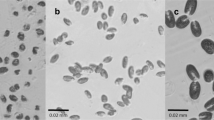Abstract
In order to conduct experiments on interactions between animals and food organisms, it is necessary to develop a medium that adequately supports the growth of both algae and zooplankton without the need to alter the medium to accommodate either the algae or the animals. We devised a freshwater medium, named COMBO, that supports excellent growth of both algae and zooplankton. Two types of algae, Ankistrodesmus falcatus and Stephanodiscus hantzschii, were reared in COMBO and their growth rates were not significantly different from those of algae grown in a reference medium (WC). One of these algae, A. falcatus, was then fed to a cladoceran, Daphnia pulicaria, which was also cultured in COMBO, and the resulting fecundities of D. pulicaria were compared to those of animals reared in natural surface water. We also determined whether the value of COMBO as a medium for D. pulicaria was affected by modifications in nitrogen or phosphorus concentration to evaluate whether the new medium will be useful in nutritional research. Lowering the N or P content of COMBO did not affect the reproductive performance of D. pulicaria. Other researchers have also reported excellent growth and reproduction by numerous algae and zooplankton reared in COMBO. Our results suggest that COMBO is an effective artificial, defined culture medium capable of supporting robust growth and reproduction of both freshwater algae and zooplankton.
Similar content being viewed by others
References
Becker, E.W., 1994. Microalgae. Biotechnology and Microbiology. Cambridge University Press, 293 pp.
Brand, L. E., 1981. The effects of continuous light and light intensity on the reproduction rates of twenty-two species of marine phytoplankton. J. exp. mar. Biol. Ecol. 50: 119–132.
Brand, L. E., R. R. L. Guillard & L. S. Murphy, 1981. A method for the rapid and precise determination of acclimated phytoplankton reproductive rates. J. Plankton Res. 3: 93–101.
Carmichael, W. W. & P. R. Gorham, 1974. An improved method for obtaining axenic clones of planktonic blue-green algae. J. Phycol. 10: 238–240.
Conklin, D. E. & L. Provasoli, 1977. Nutritional requirements of the water flea, Moina macrocopa. Biol. Bull. 152: 337–350.
Elendt, B. P. & W. R. Bias, 1990. Trace nutrient deficiency in Daphnia magna cultured in standard medium for toxicity testing: effects of the optimization of culture conditions on life history parameters of Daphnia magna. Wat. Res. 24: 1157–1167.
Goulden, C. E., L. L. Henry & A. J. Tessier, 1982. Body size, energy reserves, and competitive ability in three species of Cladocera. Ecology 63: 1780–1789.
Guillard, R. R. L., 1975. Culture of phytoplankton for feeding marine invertebrates. In W. L. Smith & M. H. Chantey (eds), Culture of Marine Invertebrate Animals. Plenum Publishers, New York: 29–60.
Guillard, R. R. L. & P. E. Hargraves, 1993. Stichochrysis immobilis is a diatom, not a chrysophyte. Phycologia 32: 234–236.
Keating, K. I., 1985. A system of defined (sensu stricto) media for daphnid (Cladocera) culture. Wat. Res. 19: 73–78.
Keating, K. I., P. B. Caffrey & K. A. Schultz, 1989. Inherent problems in reconstituted water. In U. M. Cowgirl & L. R. Williams (eds), Aquatic Toxicology and Hazard Assessment, Vol. 12. ASTM STP 1027: 367–378.
Keller, M. D., R. C. Selvin, W. Claus & R. R. L. Guillard, 1987. Media for the culture of oceanic ultraphytoplankton. J. Phycol. 23: 633–638.
Kilham, S. S., D. A. Kreeger, C. E. Goulden & S. G. Lynn, 1997a. Effects of nutrient limitation on biochemical constituents of Ankistrodesmus falcatus. Freshwat. Biol. 38: 591–596.
Kilham, S. S., D. A. Kreeger, C. E. Goulden & S. G. Lynn, 1997b. Effects of algal food quality on fecundity and population growth rates of Daphnia. Freshwat. Biol. 38: 639–647.
Klaveness, D. & R. R. L. Guillard, 1975. The requirement for silicon in Synura petersenii (Chrysophyceae). J. Phycol. 11: 349–355.
Kreeger, D. A. & C. J. Langdon, 1993. Effect of dietary protein content on growth of juvenile mussels, Mytilus trossulus (Gould 1850). Biol. Bull. 185: 123–139.
Lehman, J. T. 1976a. Photosynthetic capacity and luxury uptake of carbon during phosphate limitation in Pediastrum duplex (Chlorophyceae). J. Phycol. 12: 190–193.
Lehman, J. T. 1976b. Ecological and nutritional studies on Dinobryon Ehrenb.: Seasonal periodicity and the phosphate toxicity problem. Limnol. Oceanogr. 21: 646–658.
Marking, L. L.& V. K. Dawson, 1973. Toxicity of quinaidine sulfate to fish. Invest. Fish Contr. No. 48, U.S. Fish andWildlife Service, Washington, D.C, 8 pp.
Morel, F. M. M., J. C. Westall, J. G. Reuter & J. P. Chaplick, 1975. Description of the algal growth media 'Aquil' and 'Fraquil'. Water Quality Laboratory, Ralph Parsons Laboratory for Water Resources and Hydrodynamics, Massachusetts Institute of Technology, Technical Report 16, 33 pp.
Murphy, J. & M. Davidoff, 1972. The result of improved nutrition on the Lansing effect in Moina macrocopa. Biol. Bull. 142: 302–309.
Rand, G. M. 1995. Fundamentals of Aquatic Toxicology. Effects, Environmental Fate and Risk Assessment. 2nd edn. Taylor and Francis, Washington.
Stein, J. R. (ed.), 1973. Handbook of Phycological Methods: Culture Methods and Growth Measurements. Cambridge University Press, 448 pp.
Urabe, J., J. Clasen & R. W. Sterner, 1997. Phosphorous limitation of Daphnia growth: Is it real? Limnol. Oceanogr. 42: 1436–1443.
Rights and permissions
About this article
Cite this article
Kilham, S.S., Kreeger, D.A., Lynn, S.G. et al. COMBO: a defined freshwater culture medium for algae and zooplankton. Hydrobiologia 377, 147–159 (1998). https://doi.org/10.1023/A:1003231628456
Issue Date:
DOI: https://doi.org/10.1023/A:1003231628456




